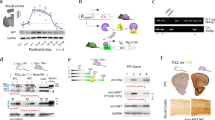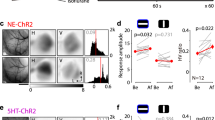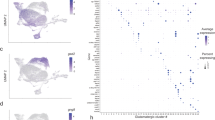Abstract
During critical periods of development, experience shapes cortical circuits, resulting in the acquisition of functions used throughout life. The classic example of critical-period plasticity is ocular dominance (OD) plasticity, which optimizes binocular vision but can reduce the responsiveness of the primary visual cortex (V1) to an eye providing low-grade visual input. The onset of the critical period of OD plasticity involves the maturation of inhibitory synapses within V1, specifically those containing the GABAA receptor α1 subunit. Here we show that thalamic relay neurons in mouse dorsolateral geniculate nucleus (dLGN) also undergo OD plasticity. This process depends on thalamic α1-containing synapses and is required for consolidation of the OD shift in V1 during long-term deprivation. Our findings demonstrate that thalamic inhibitory circuits play a central role in the regulation of the critical period. This has far-reaching consequences for the interpretation of studies investigating the molecular and cellular mechanisms regulating critical periods of brain development.
This is a preview of subscription content, access via your institution
Access options
Access Nature and 54 other Nature Portfolio journals
Get Nature+, our best-value online-access subscription
$29.99 / 30 days
cancel any time
Subscribe to this journal
Receive 12 print issues and online access
$209.00 per year
only $17.42 per issue
Buy this article
- Purchase on Springer Link
- Instant access to full article PDF
Prices may be subject to local taxes which are calculated during checkout






Similar content being viewed by others
References
Wiesel, T. N. & Hubel, D. H. Single-cell responses in striate cortex of kittens deprived of vision in one eye. J. Neurophysiol. 26, 1003–1017 (1963).
Huang, Z. J. et al. BDNF regulates the maturation of inhibition and the critical period of plasticity in mouse visual cortex. Cell 98, 739–755 (1999).
Hensch, T. K. et al. Local GABA circuit control of experience-dependent plasticity in developing visual cortex. Science 282, 1504–1508 (1998).
Fagiolini, M. & Hensch, T. K. Inhibitory threshold for critical-period activation in primary visual cortex. Nature 404, 183–186 (2000).
Hanover, J. L., Huang, Z. J., Tonegawa, S. & Stryker, M. P. Brain-derived neurotrophic factor overexpression induces precocious critical period in mouse visual cortex. J. Neurosci. 19, RC40 (1999).
Fagiolini, M. et al. Specific GABAA circuits for visual cortical plasticity. Science 303, 1681–1683 (2004).
Carulli, D. et al. Animals lacking link protein have attenuated perineuronal nets and persistent plasticity. Brain 133, 2331–2347 (2010).
Kuhlman, S. J. et al. A disinhibitory microcircuit initiates critical-period plasticity in the visual cortex. Nature 501, 543–546 (2013).
Stephany, C. E. et al. Plasticity of binocularity and visual acuity are differentially limited by nogo receptor. J. Neurosci. 34, 11631–11640 (2014).
Bosman, L. W., Heinen, K., Spijker, S. & Brussaard, A. B. Mice lacking the major adult GABAA receptor subtype have normal number of synapses, but retain juvenile IPSC kinetics until adulthood. J. Neurophysiol. 94, 338–346 (2005).
Sur, C. et al. Loss of the major GABA(A) receptor subtype in the brain is not lethal in mice. J. Neurosci. 21, 3409–3418 (2001).
Vicini, S. et al. GABA(A) receptor alpha1 subunit deletion prevents developmental changes of inhibitory synaptic currents in cerebellar neurons. J. Neurosci. 21, 3009–3016 (2001).
Gorski, J. A. et al. Cortical excitatory neurons and glia, but not GABAergic neurons, are produced in the Emx1-expressing lineage. J. Neurosci. 22, 6309–6314 (2002).
Taniguchi, H. et al. A resource of Cre driver lines for genetic targeting of GABAergic neurons in cerebral cortex. Neuron 71, 995–1013 (2011).
Vong, L. et al. Leptin action on GABAergic neurons prevents obesity and reduces inhibitory tone to POMC neurons. Neuron 71, 142–154 (2011).
Vue, T. Y. et al. Sonic hedgehog signaling controls thalamic progenitor identity and nuclei specification in mice. J. Neurosci. 29, 4484–4497 (2009).
Frenkel, M. Y. & Bear, M. F. How monocular deprivation shifts ocular dominance in visual cortex of young mice. Neuron 44, 917–923 (2004).
Sato, M. & Stryker, M. P. Distinctive features of adult ocular dominance plasticity. J. Neurosci. 28, 10278–10286 (2008).
Ranson, A., Cheetham, C. E., Fox, K. & Sengpiel, F. Homeostatic plasticity mechanisms are required for juvenile, but not adult, ocular dominance plasticity. Proc. Natl. Acad. Sci. USA 109, 1311–1316 (2012).
Kaneko, M., Stellwagen, D., Malenka, R. C. & Stryker, M. P. Tumor necrosis factor-alpha mediates one component of competitive, experience-dependent plasticity in developing visual cortex. Neuron 58, 673–680 (2008).
Kralic, J. E. et al. Compensatory alteration of inhibitory synaptic circuits in cerebellum and thalamus of gamma-aminobutyric acid type A receptor alpha1 subunit knockout mice. J. Comp. Neurol. 495, 408–421 (2006).
Sommeijer, J. P. & Levelt, C. N. Synaptotagmin-2 is a reliable marker for parvalbumin positive inhibitory boutons in the mouse visual cortex. PLoS One 7, e35323 (2012).
Donato, F., Rompani, S. B. & Caroni, P. Parvalbumin-expressing basket-cell network plasticity induced by experience regulates adult learning. Nature 504, 272–276 (2013).
Bickford, M. E. et al. Synaptic development of the mouse dorsal lateral geniculate nucleus. J. Comp. Neurol. 518, 622–635 (2010).
Howarth, M., Walmsley, L. & Brown, T. M. Binocular integration in the mouse lateral geniculate nuclei. Curr. Biol. 24, 1241–1247 (2014).
Rompani, S. B. et al. Different modes of visual integration in the lateral geniculate nucleus revealed by single-cell-initiated transsynaptic tracing. Neuron 93, 767–776.e6 (2017).
Piscopo, D. M., El-Danaf, R. N., Huberman, A. D. & Niell, C. M. Diverse visual features encoded in mouse lateral geniculate nucleus. J. Neurosci. 33, 4642–4656 (2013).
Cox, C. L., Zhou, Q. & Sherman, S. M. Glutamate locally activates dendritic outputs of thalamic interneurons. Nature 394, 478–482 (1998).
Blitz, D. M. & Regehr, W. G. Timing and specificity of feed-forward inhibition within the LGN. Neuron 45, 917–928 (2005).
Vigeland, L. E., Contreras, D. & Palmer, L. A. Synaptic mechanisms of temporal diversity in the lateral geniculate nucleus of the thalamus. J. Neurosci. 33, 1887–1896 (2013).
Kuhlman, S. J., Lu, J., Lazarus, M. S. & Huang, Z. J. Maturation of GABAergic inhibition promotes strengthening of temporally coherent inputs among convergent pathways. PLOS Comput. Biol. 6, e1000797 (2010).
Linden, M. L., Heynen, A. J., Haslinger, R. H. & Bear, M. F. Thalamic activity that drives visual cortical plasticity. Nat. Neurosci. 12, 390–392 (2009).
Stellwagen, D. & Shatz, C. J. An instructive role for retinal waves in the development of retinogeniculate connectivity. Neuron 33, 357–367 (2002).
Hooks, B. M. & Chen, C. Distinct roles for spontaneous and visual activity in remodeling of the retinogeniculate synapse. Neuron 52, 281–291 (2006).
Thompson, A. D., Picard, N., Min, L., Fagiolini, M. & Chen, C. Cortical feedback regulates feedforward retinogeniculate refinement. Neuron 91, 1021–1033 (2016).
Crewther, D. P. & Crewther, S. G. A new model of strabismic amblyopia: loss of spatial acuity due to increased temporal dispersion of geniculate X-cell afferents on to cortical neurons. Vision Res. 114, 79–86 (2015).
Zhou, Y., Yu, H., Yang, Y. & Shou, T. Non-dominant eye responses in the dorsal lateral geniculate nucleus of the cat: an intracellular study. Brain Res. 987, 76–85 (2003).
Sestokas, A. K. & Lehmkuhle, S. The effects of monocular deprivation on the visual latency of geniculate X- and Y-cells in the cat. Brain Res. 395, 93–95 (1986).
Wiesel, T. N. & Hubel, D. H. Effects of visual deprivation on morphology and physiology of cells in the cats lateral geniculate body. J. Neurophysiol. 26, 978–993 (1963).
Eysel, U. T., Grüsser, O. J. & Hoffmann, K. P. Monocular deprivation and the signal transmission by X- and Y-neurons of the cat lateral geniculate nucleus. Exp. Brain Res. 34, 521–539 (1979).
Heimel, J. A., Hartman, R. J., Hermans, J. M. & Levelt, C. N. Screening mouse vision with intrinsic signal optical imaging. Eur. J. Neurosci. 25, 795–804 (2007).
Tyler, C. W., Apkarian, P., Levi, D. M. & Nakayama, K. Rapid assessment of visual function: an electronic sweep technique for the pattern visual evoked potential. Invest. Ophthalmol. Vis. Sci. 18, 703–713 (1979).
Brainard, D. H. The psychophysics toolbox. Spat. Vis. 10, 433–436 (1997).
Harris, K. D., Henze, D. A., Csicsvari, J., Hirase, H. & Buzsáki, G. Accuracy of tetrode spike separation as determined by simultaneous intracellular and extracellular measurements. J. Neurophysiol. 84, 401–414 (2000).
Saiepour, M. H. et al. Ocular dominance plasticity disrupts binocular inhibition-excitation matching in visual cortex. Curr. Biol. 25, 713–721 (2015).
Acknowledgements
We thank C. Lohmann and C. Niell for the critical reading of the manuscript, E. Ruimschotel for technical assistance, and Y. Nakagawa and A. McGee for providing the Olig3-cre mouse line. This project has received funding from the European Union’s Horizon 2020 Research and Innovation Programme under Grant Agreement No. 720270 (HBP SGA1). It was further funded through a grant from AgentschapNL to the NeuroBasic PharmaPhenomics consortium (C.N.L.), a NWO grant (823.02.001) to C.N.L., a grant from Stichting Blindenhulp, a donation from Praktijkgenerator b.v., a Veni grant from the NWO to R.M. (863.12.006) and a Vidi grant from the NWO to J.A.H. (864.10.010).
Author information
Authors and Affiliations
Contributions
J.-P.S. and K.S. performed immunohistochemical analyses; J.-P.S. and M.H.S. performed intrinsic signal imaging; J.-P.S. did western blot analyses; M.A. performed the in vivo electrophysiology; R.M. performed slice electrophysiology; J.P.S., M.A., M.H.S., K.S. and R.M. conceived the experiments, performed data analyses and helped writing the manuscript; J.A.H. developed analysis tools, performed data analyses and helped with the writing; C.N.L. conceived the research line, oversaw the project and wrote the paper.
Corresponding author
Ethics declarations
Competing interests
The authors declare no competing financial interests.
Additional information
Publisher’s note: Springer Nature remains neutral with regard to jurisdictional claims in published maps and institutional affiliations.
Integrated supplementary information.
Supplementary Figure 1 Expression of GABAA receptor α1 subunit in interneurons subsets.
a, Experimental setup. A monitor was positioned at 15 cm distance with the right half of the screen in the mouse’s right monocular visual field. 0.05 cpd drifting gratings appear in each of the quadrants of the screen. Visual stimulation of both eyes in each of the four monitor quadrants decreased reflectance of 700 nm light in different patches of left visual cortex, and response pixels are color coded (middle panel), resulting in a color coded retonotopic representation right panel). Images are the average of 15 repetitions. A region of interest (ROI) polygon was drawn covering pixels corresponding to the superior binocular visual field. A region of reference (ROR) polygon is drawn in a visually unresponsive area. b, Experimental time-line. For assessment of ocular dominance (OD) plasticity during the critical period mice were imaged at P35, and some mice were deprived from P28 to P35. c, Upper panel: α1 expression in cortical interneurons can be visualized in Gabra1fl-hom Emx1-cre+ mice. Lower panels: Expression of α1 and the interneuron markers reelin, PV, SST and VIP in cortical interneurons in Gabra1fl-hom Emx1-cre+ mice. d, Upper panels: α1 expression on the cell surface of PV+ interneurons is high. Lower panel: high α1 expression in PV + interneurons is lost in Gabra1fl-hom Gad2-cre+ mice. e, A significant OD shift is induced by 3 days of monocular deprivation of Gabra1fl-hom Gad2-cre+ Emx1-cre+ mice. t-test, P=0.008. Scale bars are 20 μm. Values shown as mean ± s.e.m. **P<0.01.
Supplementary Figure 2 Western blots of GABAA receptor components in Gabra1-/- mice and wild type littermates.
Uncropped gel runs of western blots quantified in Fig. 3. White arrows indicate the signals representing α1, α2, α3, gephyrin and γ2. Red bands are molecular weight markers, representing from top to bottom: 250, 150, 100, 37, 20, 15 and 10 kD. At the top of each lane is indicated whether the sample was from a mouse positive or negative for Gabra1.
Supplementary Figure 3 Examples and properties of binocular dLGN cells.
a, Examples of linear micro-electrode traces (red) through ipsilateral projection zone of dLGN of non-MD (left) and MD (right) wild type mice. Scale bar=500 µm. b, Top: example of clustering units based on two principal components of spike features. Bottom: waveforms of the corresponding data are represented on the right. Data colored in green belong to a single-unit. Data in blue correspond to other threshold-crossed voltage changes. c, Each row shows firing rates over time of an example cell (SU) recorded in wild type mice, while either the contralateral (red) or ipsilateral (black) eye is exposed to the full screen, 1.5s visual stimulus. The SU shown in the top row top has a very sustained response. The unit shown below has a transient response to the ipsilateral eye. The last example has an ON/OFF response to the contralateral eye and only an OFF response to the ipsilateral eye.
Supplementary Figure 4 Recordings in dLGN of Gabra1fl hom Olig3-Cre+ mice.
a, Receptive fields of MUs recorded in non MD (light green) and MD (dark green) Gabra1fl hom Olig3-Cre+ mice (n=41 and 25 MUs, respectively). The position of the nose of the mouse is at horizontal and vertical 0 cm. The red dashed lines indicate -30o and +30o horizontal angles. b, Examples of linear micro-electrode traces (red) through ipsilateral projection zone of dLGN of non-MD (left) and MD (right panels) Gabra1fl-hom Olig3-cre+ mice, stained by DAPI (blue). White line delineates dLGN. Scale bar=500 µm.
Supplementary information.
Supplementary Text and Figures
Supplementary Figures 1–4
Supplementary Tables
Supplementary Tables 1 and 2
Rights and permissions
About this article
Cite this article
Sommeijer, JP., Ahmadlou, M., Saiepour, M.H. et al. Thalamic inhibition regulates critical-period plasticity in visual cortex and thalamus. Nat Neurosci 20, 1715–1721 (2017). https://doi.org/10.1038/s41593-017-0002-3
Received:
Accepted:
Published:
Issue Date:
DOI: https://doi.org/10.1038/s41593-017-0002-3
This article is cited by
-
Host interneurons mediate plasticity reactivated by embryonic inhibitory cell transplantation in mouse visual cortex
Nature Communications (2021)
-
The underdog pathway gets a boost
Nature Neuroscience (2017)



